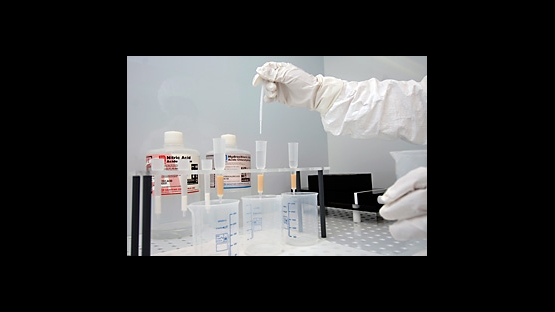For almost 50 years the IAEA´s laboratories at Seibersdorf in Austria and in Monaco have been undertaking groundbreaking research in areas like agriculture, climate change and water pollution; research that directly supports the continued growth of developing Member States.
These laboratories also play a crucial role in verifying countries´ declared nuclear activity and building confidence that no undeclared activity is underway.
The labs come under the Department of Nuclear Sciences and Applications and the Department of Safeguards.
Safeguards
The IAEA Safeguards Analytical Laboratory (SAL) analyzes samples taken during inspections of more than 900 nuclear facilities around the world. It is the analytical centre of the Agency, which measures the isotopic signature of nuclear samples, i.e. determining the exact composition of a sample.
SAL is also involved in training safeguard inspectors, developing and maintaining on-site and field-installed analytical laboratories, as well as developing methods for the analysis of radioactive material.
Now the Clean Lab, where technicians evaluate environmental samples collected from the field, is being expanded, enabling inspectors to scrutinise a larger number of environmental samples more accurately.
"Extending the Clean Laboratory will provide the IAEA with a significantly enhanced ability to detect whether States under Safeguards are conducting any undeclared nuclear activities," says Gabriele Voigt, Director of the Office of Safeguards Analytical Laboratories.
Nuclear Sciences and Applications (NA)
The work undertaken in these laboratories has a direct impact on people living in the IAEA´s developing Member States - whether it´s villagers in Bangladesh who now have arsenic-free drinking water because of the advances made in the Isotope Hydrology laboratory; or farmers in Mexico and Chile whose crops are protected from the Medfly´s destructive foraging thanks to progress made in Sterile Insect Technique by the Entomology lab.
The work of the three main labs (the FAO/IAEA Agriculture and Biotechnology Laboratory; the Physics, Chemistry and Instrumentation Laboratory; as well as the IAEA Environmental Laboratory), together with their subsidiary units, covers a wide range of issues like plant breeding - developing drought and salt resistant crops with better yield - climate change, ocean acidification, natural resource management, environmental pollution, animal production and health, and insect pest control.
In the labs, IAEA experts train scientists from developing Member States, provide countries with technical advice so they can use nuclear technology more effectively, as well as develop and modifying nuclear instruments.
The NA labs, which employ over 50 professionals and 80 technicians in Monaco and Seibersdorf, have been reorganised to streamline administration and communication.
"The IAEA´s programmes will benefit tremendously from the recent administrative restructuring. Each group of labs in conjunction with their counterparts at headquarters will now be able to react more quickly and give greater focus to the many requests for support from our Member States," says Qu Liang, Director of the Joint FAO/IAEA Division of Nuclear Techniques in Food and Agriculture.
Background
The units of the NA labs specialize in radiometrics, radioecology and marine environmental studies; developing and adapting agricultural technologies using radioisotopes and nuclear techniques; and ensuring that places like cancer treatment centres consistently provide the right radiation dose to patients.
The units of the SAL lab are the Chemical Analysis unit, involved in the preparation of isotopic samples and their analysis; Isotopic Analysis unit, which conducts a more in-depth analysis of uranium and plutonium; and the Quality Assurance and Computer Services group that assesses the results of other units to make sure the work of the laboratory meets the necessary standards.


